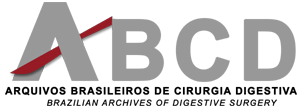BACKGROUND:
The choledocolithiasis has an incidence of 8-20% in patients with cholecystolithiasis. The preoperative diagnosis guides the interventional treatment on the bile duct
AIM:
To evaluate the sensitivity and specificity of the laboratory markers and imaging studies for choledocholithiasis preoperatively.
METHODS:
The study comprised 254 patients divided into two groups: the control group (207 patients), patients without choledocholithiasis intraoperatively and cases group (47 patients), that enrolled the patients with choledocholithiasis intra-operatively. Were evaluated the laboratory markers, image exams and intra-operative diagnostic aspects.
RESULTS:
The sample was homogeneous for age and gender. It was observed that 47% of the cases the patients did not show comorbidities. Hospitalization showes in cases group acute pancreatitis in12.8%, jaundice in 30%, fever in 30% and pain in the right hypochondrium in 95%. By comparing them, was observed that fever and jaundice were the signs and symptoms with statistical significance. Patients with choledocholithiasis had transaminases, alkaline phosphatase, gamma-glutamyl transferase and higher bilirubin with statistical significance (p<0.001). In regard to imaging studies, ultrasound was fairly accurate for cholelithiasis and choledocholithiasis (p<0.001).
CONCLUSION:
Changes in canalicular and transaminase enzymes are suggestive for preoperative choledocholithiasis; GGT showed better sensitivity and alkaline phosphatase greater specificity; ultrasonography and nuclear magnetic resonance cholangiopancreatography showed high specificity.
Choledocholithiasis; clholelithiasis; jaundice
